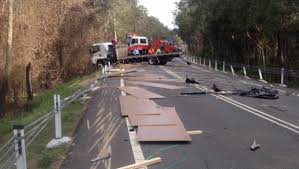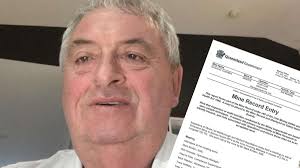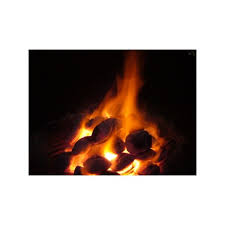
North Goonyella Mine Fire 22nd October 2018. “Whilst travelling along MG9N road it was observed that all tube bundle lines were run along the eastern side of the road edge. I discussed with Mr Anger and Mr Romenski the potential for damage to these lines from vehicles due to no demarcation or protection from vehicles.
MRE – North Goonyella – 22.10.2018.pdf
During an Inspection of the Surface Facilities Inspector Nugent made the following observation and comment.
Whilst travelling along MG9N road it was observed that all tube bundle lines were run along the eastern side of the road edge. I discussed with Mr Anger and Mr Romenski the potential for damage to these lines from vehicles due to no demarcation or protection from vehicles. Mr Anger stated that reflective guide posts had been planned to be placed approximately every 20m inside the tube bundle lines along the roads and would follow up to ensure work is expedited.
What can anyone say?
The Mine has
- Lost all installed Tube Bundle Monitoring Lines Underground after the Fire and apparent subsequent explosion.
- Abandoned Control Room and Gas Monitoring and Analysis Facilities
- Had to recover SIMTARS mobile lab from the Exclusion Zone.
- Has next to no gas monitoring in place and has been trying for 3 weeks to establish some.
Why wouldn’t you just run the new Tube Bundle Lines just on the edge of the road with no protection let alone demarcation? What could possibly happen?
Guideposts every 20M at some point in the future will fix everything.
On Monday 22 October 2018 Inspector Geoff Nugent attend the North Goonyella Mine
Accommodation Village to attend a meeting in regard to progress on dealing with the spontaneous combustion event, arriving at 7:30am.
Meeting commenced at 0830hrs Monday 22 October 2018
Attendees —
John Anger (SSE), Gareth Prichard (Electrical Maintenance Planner), Chris Markowski (Tech Services), Marek Romenski (UMM), Geoff Nugent (Mines Inspector, Lee Earnshaw (Development Coordinator), John Pearson (SSHR).
Dial in —David Cliff (Consultant), Michael Brady (Consultant), Darren Brady (Consultant) Steven Woods (ISHR), Martin Watkinson (SIMTARS), Charles Lilly (Director of engineering Peabody USA), Peter Baker (VP Peabody Australia), Mike Carter (SEE Millennium Mine), Neville Impson (Compliance Manger)
Last 24hrs
Gag on stand-by both shifts.
GN2710 -TG Chute OB- ROCSIL applied down hole, 272m3 pumped, rig packed up heading to GN2706 GN2707 – MG A Hdg 0B ROCSIL hole – Rig1218 – Drilled to casing depth and pulled out of hole, cased and grouted in @ 02:35, waiting on grout to cure, commence drilling cement shoe at 14:30 GN2706 – MG 2ct – 2nd ROCSIL hole – Rig 1265 – Holed into workings Ran fish eye in hole identified reaming required. Mesh wrapped around bit having trouble tripping out rods. Once clear will run fish eye and penetrator (NGC developed camera) down hole. CS Gas rig setting up at hole.
Boreholes status;
GN2723 – E59 intersection monitoring hole – Rig1283 – Drilled out rat hole, on standby due to incompatibility with steering gear from Rig1265. Rig 1283 moved to assist with grout work, cant drill angled holes.
GN2705 – Poured 2 lots of 72.5m3 grout/cement product into hole. (3 so far), 210m3 in hole. Hard tag 2nd pour, 602mm added since first pour.
GN2714 – TG B Hdg I/B ROCSIL plug hole – RIG 1226 – Drilled to 281mts
GN2697 (TG chute road) breathing out heavily, bag sample similar to 2700. Discussion around best way forward with these seals. Will pour first 600mm layer, put rocsil plug in GN2700 as a back up, drill another monitoring hole adjacent to GN2700
Mitchells had a safe stop session between DS/NS. Addressed crews and thanked them for their efforts especially in this unusual situation. Stressed the importance of looking out for each other and the refreshed the safe start principles. Well received.
Borehole monitoring 6 hrly, at 1-19, 10.5ct MG9N, 36 D-E, and 32G, 12hrly at GN2698 and GN2695, sampled also GN2697 (TG Chute Rd 1B ROCSIL hole) as it was breathing out – Sample returned similar to goaf gas samples. 25ct 9N producing fresh air again, will try one more time to get an effective sampling point otherwise will seal hole.
Carted breaker rock to 1:4 for emergency sealing
Continued TB integrity checks, have completed all tubes connected to hut on surface. Checking surface to underground connections next 24hrs. Bleeder TB still to be run to depth. Floxal 1, 2, 6 and NGC unit running during both shifts
RADON survey continued (80 cups read) – completed field works now, awaiting results
Temp reading at H9 taken: 09:00-29deg, 15:00-56 deg, 21:00-31 deg & 03:00 27 deg.
Footage obtained from hole in GN2709 – concrete hole in TG chute – unable to get through mesh however clear picture of roof bolts.
Took camera down 2705 to check grout once poured
Dips on 10N water level – 473m vs 472m 24hr prior – will continue monitoring
Discussed options for borehole pumps for 10N, decision point today
Surveyor checked pressure sampling points against plan, one error identified
Next 24
GAG – Planned to continue keep GAG shut down for next 24hrs and observe conditions with unit on standby and complete maintenance. This will continue on a day by day basis Continue drilling for LW containment
Continue cementing seal at MG Chute Road (Cement down GN2705) between ROCSIL plugs – 4 more layers to go, potential completion Tuesday. Start GN2709 grout process, run pipe across road.
Continue sampling regime and setting up tubes at sample points – Bleeder shaft sampling point.
Confirm sample points against survey location.
Camera down GN2706 to view into workings
Carting coarse reject to 1:4
Rocsil plug NS GN2706 2ct chute 0B plug
Continue Tube bundle integrity testing, 25ct 9N focus for day
Continue taking and tracking pressure readings at borehole locations
Review borehole pump possibilities for 10N – 18ct. Telecon with CMT
Continue Floxal injection down 1.5 ct 9N, 6ct ION in the corridor, 42 ct(Stone dust silo), 3ct MG 9N.
Review overall floxal strategy and determine location for idle units
Geoglide senior management onsite today to discuss compatibility of their directional steering units with the rig which is slightly different to the UDR 1200
Investigate rating of 1:4 if top blast door with the existing rocsil, concrete and earth RADON survey results presentation at 14:30
Meeting Notes
Photos from NGC camera down GN2709 displayed. Images clear but only could see mesh and a couple of roof bolt ends at top of hole. NGC continue to have difficulty getting cameras in seam due to roof mesh restriction at the bottom of each hole. When rods are inserted for concreting, fish eye camera will be inserted inside rods to attempt to get vision from inseam. The poly pipe gopro arrangement will not fit inside drill rods.
Darren Brady noted that sample point H9 130m had consistent higher 02 than H9 10m sample point. Could be effect of stagnate airflow, will continue to monitor.
Discussion re TG Chute boreholes GN2700 breathing in but GN 2697 approx 20m outbye in chute road strongly breathing out. Unable to be explained at this point, boreholes will be pressure tested again today to confirm readings and consistency of pressure differential.
Geoff Nugent asked if consideration have been given to setting alarms on TB monitoring system e.g. flow monitoring and gas alarms to identify change early. No gas alarms yet established flow monitoring is in place for TB lines.
Site Inspection
Accompanied by Mr John Anger (SSE), Mr Marek Romanski (UMM), Mr John Pearson (SSHR) and Mr Daniel Harrington (ERZC) I conducted an inspection of borehole locations Tailgate Chute road GN2700, GN2697 and MG9 North 25ct GN1997.
At 1045hrs the inspection group followed the mine site entry process and signed in at the lease boundary security gate and collected individual SCSR’s.
The group then travelled to the TG Chute surface area to observe boreholes GN2697and GN2700. It was reported earlier at the 830hrs briefing that GN2697 was breathing out and that the Rocsil plug earlier installed beneath the borehole may be compromised and borehole GN2700 was breathing in.
The barometer during the time of inspections was 980hpa and falling.
Borehole GN2697 was observed to be capped also with a foam product sprayed around the cap. A tube bundle line was inserted through the cap with tape blanking the end of the TB line outside the borehole. This TB line is not connected to the tube bundle hut (TBH). Mr Harrington (ERZC) checked for gas around the borehole with his PGD finding none present. Mr Harrington then removed the tape blanking the TB line and confirmed the borehole was notably breathing out, no pressure reading was taken.
The group then walked to borehole GN2700 which had a pipe arrangement on top of the borehole with butterfly valves closed off, sealing the borehole. A tube bundle line was inserted into the borehole which, I was informed reported to the NGC TBH near H40 shaft. Mr Harington checked for gas with his PGD around the borehole finding none. Mr Harington then slightly opened a butterfly valve and confirmed the borehole was breathing out.
The group then travelled by vehicle via MG 9N surface road to 9N 25ct borehole. Whilst travelling along MG9N road it was observed that all tube bundle lines were run along the eastern side of the road edge. I discussed with Mr Anger and Mr Romenski the potential for damage to these lines from vehicles due to no demarcation or protection from vehicles. Mr Anger stated that reflective guide posts had been planned to be placed approximately every 20m inside the tube bundle lines along the roads and would follow up to ensure work is expedited.
When the group arrived at MG 9N 25ct borehole Mr Matt Irelandes (ERZC) was at the borehole having just completed a borehole pressure reading. Mr Irelandes reported that the reading he took was 1.1kpa negative pressure, an increase from previous readings. The borehole was capped with foam product sprayed around it. The cap had two outlets, one with a tube bundle line inserted which, I was informed, the end of line reached into the seam below and also reported to the NGC TBH. The second outlet had a tap arrangement with a short TB line inserted for the purpose of taking pressure readings. The TB line outlets were partly secured by duct tape which formed a poor seal providing leakage paths. Mr Anger stated that new fit for purpose borehole caps have recently been manufactured which have provision for properly fitted tube bundle and pressure monitoring outlets eliminating leakage paths, and will be fitted as soon as practicable.
At 1135hrs the group returned to mine boundary security gate, signed out and returned SCSR’s. Prior to leaving the security area Mr Anger located and showed the newly manufactured borehole caps which will be fitted to boreholes as soon as practicable.
Presentation — Radon Survey Preliminary Results
Today at 1430hrs I attended a presentation on the preliminary results from the recently conducted
Radon survey above Longwall 9 Goaf.
The presentation was delivered by
Mr Geoff Watson(Study/Project Manager Peabody Aust.), Professor Jian Meig (Shanxi Provence University China.) and Mr Dennis Huo (Gas Drainage Specialist Peabody Aust. (providing language interpretation between Professor Jain Meig and the attendees)).
Other Attendees – John Anger (SSE), Gareth Prichard (Electrical Maintenance Planner), Kris Markowski
(Tech Services), Marek Romenski (UMM), Lee Earnshaw (Development Coordinator), John Pearson (SSHR), Associate Professor Yuguo Wu (Shanxi Provence University China.), Jamie Haantz (Group Director Underground Development Peabody ).
Mr Watson opened the presentation emphasising the following points;
This was the first Radon survey conducted in Queensland and the largest ever conducted in Australia.
The objective of the radon survey is to delineate zones of elevated energy.
There were 6 zones surveyed, 3 above the Longwall 9N Goaf and 3 above the Mains headings.
Professor Jain Meig via interpretation by Mr Hou explained the preliminary findings of the survey, providing the group with a determined location of the origins of the combustion event including indicated current temperature and temperature at peak of combustion event.
Although there were points identified with elevated energy readings above the Main headings 53 c/t to 59 c/t, conclusions could not be drawn due to compromised data through moisture in a number survey cups.
After general discussion the meeting concluded at 1520hrs.


